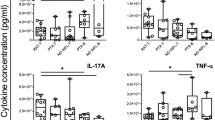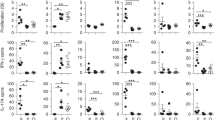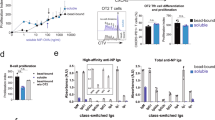Abstract
THE lymph node cells of mice rendered unresponsive by the injection of picryl sulphonic acid (PSA) depress the passive transfer of contact sensitivity1. When the mice are also painted with picryl chloride the lymph node cells produce suppressor factor in vitro. This factor depresses the passive transfer of contact sensitivity by immune cells and its production is T-cell dependent2. Here we show that suppressor factor(s) has a molecular weight ∼50,000 and that it is absorbed by and can be eluted from specific antigen in the form of picrylated albumin attached to Sepharose beads.
This is a preview of subscription content, access via your institution
Access options
Subscribe to this journal
Receive 51 print issues and online access
$199.00 per year
only $3.90 per issue
Buy this article
- Purchase on Springer Link
- Instant access to full article PDF
Prices may be subject to local taxes which are calculated during checkout
Similar content being viewed by others
References
Zembala, M., and Asherson, G. L., Nature, 244, 227–228 (1973).
Asherson, G. L., and Zembala, M., Eur. J. Immun. (in the press).
Axen, R., Porath, J., and Ernback, S., Nature, 214, 1302–1304 (1967).
Ramseier, H., and Lindenmann, J., Trans. Rev., 10, 57–96 (1972).
Okumura, K., and Tada, T., J. Immun., 112, 783–791 (1973).
Author information
Authors and Affiliations
Rights and permissions
About this article
Cite this article
ZEMBALA, M., ASHERSON, G., MAYHEW, B. et al. In vitro absorption and molecular weight of specific T-cell suppressor factor. Nature 253, 72–74 (1975). https://doi.org/10.1038/253072a0
Received:
Revised:
Issue Date:
DOI: https://doi.org/10.1038/253072a0
This article is cited by
-
From Mysterious Supernatant Entity to miRNA-150 in Antigen-Specific Exosomes: a History of Hapten-Specific T Suppressor Factor
Archivum Immunologiae et Therapiae Experimentalis (2015)
-
Helper and suppressor T cell factors
Springer Seminars in Immunopathology (1980)
-
Products of the major histocompatibility complex and their relationship to the immune response
Nature (1976)
-
Suppressor T cells in mice made unresponsive to skin allografts
Nature (1975)
Comments
By submitting a comment you agree to abide by our Terms and Community Guidelines. If you find something abusive or that does not comply with our terms or guidelines please flag it as inappropriate.



